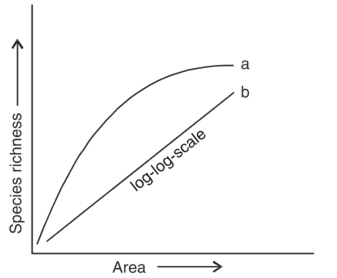 Short Answer Type
Short Answer TypeThe following graph shows the species – area relationship. Answer the following questions as directed

(a) Name the naturalist who studied the kind of relationship shown in the graph. Write the observations made by him.
(b) Write the situations as discovered by the ecologists when the value of ‘Z’ (slope of the line) lies between (i) 0.1 and 0.2 (ii) 0.6 and 1.2 What does ‘Z’ stand for ?
(c) When would the slope of the line ‘b’ become steeper ?
(a) List any three ways of measuring population density of a habitat.
(b) Mention the essential information that can be obtained by studying the population of an organism. Long Answer Type
Long Answer Type(a) Explain giving reasons why the tourists visiting Rohtang Pass or Mansarovar are advised to resume normal active life only after a few days of reaching there.
(b) It is impossible to find small animals in the polar regions. Give reasons.
 Short Answer Type
Short Answer TypeExplain Parasitism and co. evolution with the help of one example of each.
Parasitism - is a non-mutual symbiotic relationship between species, where one species, the parasite, benefits at the expense of the other, the host. For example the relationship between the human liver fluke and its hosts that is the snail and a fish.
In the case of co-evolutiion, the species interact so intimately that they can cause evolutionary changes in each other over time.The term coevolution is used to describe cases where two (or more) species reciprocally affect each other's evolution. So for example, an evolutionary change in the morphology of a plant, might affect the morphology of a herbivore that eats the plant, which in turn might affect the evolution of the plant, which might affect the evolution of the herbivore. For example, the Mediterranean orchid Ophrys bears flowers, the petals of which bear uncanny resemblance with the female bee. If there are any changes in the female bee's colour or pattern, the plant will also co-evolve to maintain the resemblance.
 Long Answer Type
Long Answer Type(a) Name the two growth models that represent populations growth and draw the respective growth curves they represent.
(b) State the basis for the difference in the shape of these curves.
(c) Which one of the curves represent the human population growth at present ? Do you think such a curve is sustainable ? Give reason in support of your answer.
 Short Answer Type
Short Answer TypeDuring a school trip to 'Rohtang pass' one of your classmate suddenly developed 'Altitude sickness'. But, she recovered after sometime.
(a) Mention one symptom to diagnose the sickness.
(b) What causes the sickness?
(c) How could she recover by herself after sometime?
 Long Answer Type
Long Answer Type(a) Represent diagrammatically three kinds of age-pyramids for the human population.
(b) How does an age pyramid for human population at given point of time helps the policy makers in planning for the future.
 Short Answer Type
Short Answer TypeWater is very essential for life. Write any three features both for plants and animals which enable them to survive in water scarce environment.
How do organisms cope with stressful external environmental conditions which are localised or of short duration?
